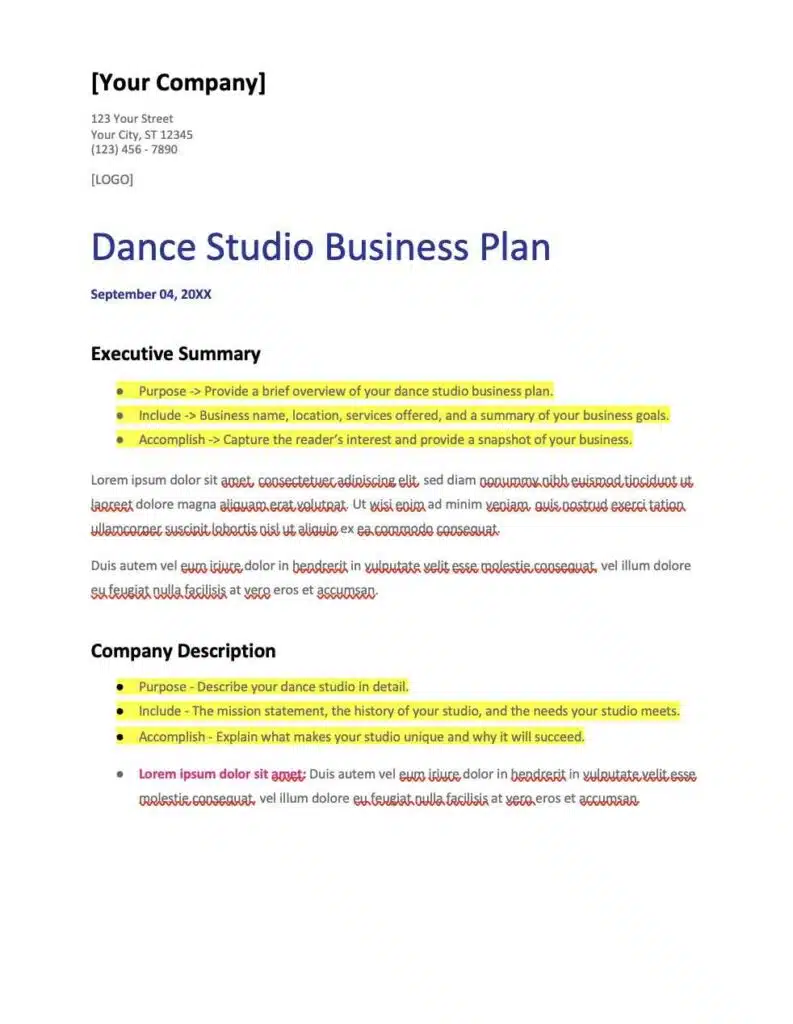Even the most passionate and creative dancers that dream of opening a studio start with a business plan. It’s easy to get carried away with the exciting elements of organizing classes and recitals, but you need a road map to help your studio grow strategically. A business plan is that road map. In its simplest form, it’s a document that lays out your studio’s future goals and how you plan to achieve them. It can be much more than that, though. The best dance studio business plan can be the foundation that keeps your studio bustling and busy for years to come. Here’s a brief overview of where to start when creating your business plan for a dance studio.

Download a Free Dance Studio Business Plan Template
PDF (Preview) | .doc (Download)
What You Need To Open A Dance Studio
In addition to your love of dance, you will need space, funding, and all necessary licensing to open your studio. Before you begin work on your complete business plan, you may want to make a running list of these essentials to help guide you to success.
The most important thing you need for your studio is up-front capital for dance studio expenses. This amount will vary based on the studio’s location and size of your studio space. Whether you buy or rent, your studio itself will likely be the largest cost associated with your dance studio finances. Beyond that, utilities, flooring, and equipment will be essential before you get up and running. You should also factor in compensation for teachers and any other positions you plan to hire.
Furthermore, every state has licensing requirements for a range of businesses. This is particularly important if your studio will offer dance instruction classes for children or individuals with special needs. Speaking with a local business law attorney to find out what is required in the legal structure and how much any licensing, permits, or other legal fees will cost can be beneficial for your financial plan and business goals.
You can find a full breakdown of your estimated dance studio costs in our earlier post. These essentials will get your studio up and running and are important to lay out in detail within your dance studio business plan.
What To Include In Your Dance Studio Business Plan
To build a successful studio, there are a few things you should consider including in your business planning. These elements will help you lay the foundation for a successful dance business. If you have multiple partners, create these together so you can arrive at a dance studio business plan everyone can agree on.

1. Executive summary
Before you dive into the nitty gritty details, it is best to provide some basic information about your dance studio. This is where you will outline your core values and objectives to set the focus for the rest of your business plan, including your business concept, target customers, key competitors, and operations plan.
This is also a good place to include a mission statement that clearly defines the “why” behind your dance studio. Think about what you strive to offer your students, employees, and community and explain how you will proudly deliver that here at your dance school.
2. Company description
Expand on your executive summary with facts regarding what your dance studio has to offer.
This is where you can dive into details about how you’ll contribute to the dance industry in your local area. What sets you apart from other studios? The best way to complete this section is to expand on your professional experience and what makes your team unique. For example, what types of dance training will be offered, what dance styles are incorporated, if there are group classes, and if it differs from a traditional dance studio. Your target customers will appreciate your instruction services.

3. Market analysis
Now it’s time for some serious data. A well-written business plan includes a competitive analysis. This is critical to explain how your studio stacks up against other studios. Do extensive research on the audience you’re targeting. Be honest about any potential challenges. Aim to research indirect competitors, direct competitors, and key competitors.
Here are some questions you should write answers to:
- What are the population demographics of your area?
- What are our business goals and how do they compare to the competitive analysis of other dance schools?
- Is this demographic a good target for bringing in a steady stream of dance students?
- How many studios will you compete against for students?
- How do other studios compare to your own dance studio?
- What are your competitors doing to be successful?
- How will you remain competitive in this market?
- What challenges will you face in reaching your targeted demographics?
- How is your customer segment different from direct competitors?
4. Organization and management
Use a flow chart to lay out which team member is in charge of what at your dance studio. Include a description of each employee’s duties and responsibilities. If you hope to expand your management team, discuss the positions you would eventually like to recruit. These other roles should include who handles marketing efforts, who manages the balance sheets, and who is the business owner.
You should also disclose what type of business you’re establishing. Will it be a limited liability company (LLC), sole proprietorship corporation, or another type of business structure? This will affect your taxes and personal liability, as well as the paperwork you need to file to register your business in your state.

5. Products and services
Here is where you get to talk about your passion. Simply put, what type of dance studio are you opening? Do you want your own dance studio business to fulfill the dream of becoming a studio that specializes in private lessons, provides superior dance instruction, and is viewed as a competitive dance school?
Discuss the different types of classes you plan to offer. Be specific about how long each class will be and whether you plan to divide them up by levels of experience. Will you offer private lessons in addition to traditional group class settings? Will you host special events or recitals? Do you plan to compete in competitions?
Provide information about the unique aspects of your curriculum. Again, this is to make your studio stand out amongst all other fitness studios, but especially other dance studios.
6. Financial projections
Think of this section as your dance studio costs and revenue blueprint.
Whether you already have the money for startup costs, or will be using investors or a bank loan, be clear about how you plan to get started. Use graphs, charts, and/or spreadsheets to detail your initial and monthly expenses, as well as projected sales. What costs will be involved? Consider your studio expenses, teacher salaries, and any software you use to automate key processes. These can all be documented in a cash flow statement, company analysis section, income statement, financial plan, and balance sheets.
This is also where you should disclose the structure you plan to use for charging your students. How much will they pay per class? Will you include an annual registration fee? Consider how often you’ll host recitals and how much you’ll charge for a ticket. Do you have plans to rent out your space or sell apparel? Be sure to be well-versed in your customer segments, target demographic, and market trends to accurately price your dance classes offered. This can ultimately give your dance studio a competitive advantage against other dance studios.
Don’t leave anything out when it comes to the money coming in and being spent. This will give you a realistic idea of what to expect on a monthly, quarterly, and yearly basis. This section can and will change over time as you learn more about the business, competitors, and your community.
Financial transparency is key to find your target audience and sticking to your operations plan.
Note any bank loans, funds contributed from angel investors, and personal savings contributions in the balance sheet.

7. Marketing strategy
There are endless ways to implement a marketing strategy so you can attract students. This is where you’ll generally discuss how you plan to do that, by incorporating marketing materials and key points.
Whether it’s through social media, in-person referrals, newspaper advertising, or a combination, develop a plan and break down the cost of each method to attract dancers to your dance studio.
8. Appendix
Create an appendix for supporting documents and other materials. This may include various contracts, permits, licenses, and credit histories.
If you are seeking financial investments for your dance studio, you may also wish to provide resumes and letters of reference that speak to your reputation and experience.
Download this Free Dance Studio Business Plan Template
Are you looking to achieve success with your new dance studio?
Download our free DOC or PDF printable example business plan template to guide you through every step. This comprehensive business plan covers everything a dance studio involves, from market research and marketing strategies to financial aspects and operating costs.
You may be a dance instructor opening a small dance studio or perhaps you are expanding your existing dance lessons, our template includes a detailed market analysis section and industry overview to ensure your dance studio’s success.
With this free business plan, dance studios can create effective business operations and marketing plans to stand out in any dance style.
Learn More About Dance Studio Industry Information
While it may seem like there are a lot of moving parts, any dance studio owner will tell you that the journey is worth it. A dance studio business plan can help you turn your vision into reality.
If you’re interested in learning more about what it takes to run a successful dance studio, The Studio Director can help. Our dance studio software can create a seamless way of tracking enrollment, billing, and much more. It takes the guesswork out of many of the ongoing tasks required for your dance studio.
We’ve also created Dance Studio Ownership 101, a free eBook with expert advice on for dance studio owners creating a business that will thrive. Download it now to learn more about opening your dream studio.


